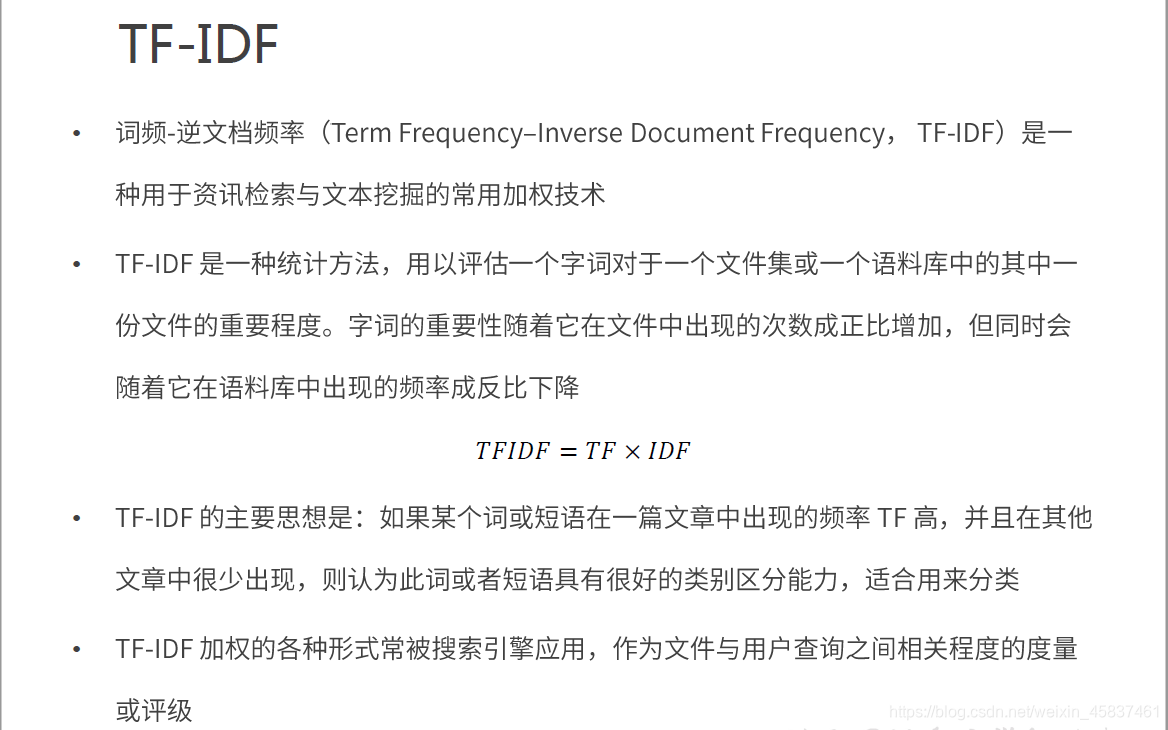TF-IDF算法原理与示例Python代码详解(Python,推荐算法)
2020-07-12 16:45
519 查看
0. 算法原理:


1. 代码实现:
# TF-IDF算法示例
'''
框架步骤:
0.引入依赖
numpy
pandas
1.数据处理
分割数据
构建词库
2.词数统计
统计文档中每个词出现的词数
3.计算词频 TF= 词语在文档出现次数/文档总词数
出现次数/总词数
4.计算逆文件频率 IDF = log(文档总数N+1)/(文档包含词语数量+1)
5.计算TF-IDF TF*IDF
'''
# 0. 引入依赖
import numpy as np
import pandas as pd
# 1. 定义数据和预处理
docA = 'The cat sat on my bed'
docB = 'The dog sat on my knees'
bowA = docA.split(' ') # 以空格为依据将数据分割
bowB = docB.split(' ')
# 构建词库
wordSet = set(bowA).union(set(bowB)) # 集合(set)是一个无序的不重复元素序列。union() 方法返回两个集合的并集,即包含了所有集合的元素,重复的元素只会出现一次。
# 2. 进行词数统计
# 用一个统计字典来保存词出现的词数
wordDictA = dict.fromkeys(wordSet, 0) # 每个字典的值从0开始统计,最后不出现的次数依然是0
wordDictB = dict.fromkeys(wordSet, 0)
# 遍历文档,统计词数
for word in bowA:
wordDictA[word] += 1
for word in bowB:
wordDictB[word] += 1
print(pd.DataFrame([wordDictA])) # 看一下结果 pd.DataFrame以表格的形式显示出来
print(pd.DataFrame([wordDictB]))
# 3. 计算词频TF
def computeTF(wordDict, bow): # wordDict: 统计次数的字典, bow: 每个文档所有的词数
# 用一个字典对象记录tf,把所有的词对应在bow文档里的tf都算出来
tfDict = {}
nbowCount = len(bow) # 计算所有的词
for word, count in wordDict.items():
tfDict[word] = count / nbowCount # 计算词频,出现词数/总词数
return tfDict
# 测试
tfA = computeTF(wordDictA, bowA)
tfB = computeTF(wordDictB, bowB)
print(pd.DataFrame(list(tfA.items()))) # 用pd.DataFrame方法直接传入dict会报错,直接将key和value取出来,都转换成list对象
print(pd.DataFrame([tfB])) # 也可以这样 但是不好看
# 4. 计算逆文档频率IDF
def computeIDF(wordDictList): # wordDict:文档的每个单词都有(key),出现的词数也有(value)
# 用一个字典对象保存IDF结果,每个词作为key,初始值为0
idfDict = dict.fromkeys(wordDictList[0], 0) # 字典dict.fromkeys(seq[, value]) 函数用于创建一个新字典,以序列中seq元素做字典的键,value为字典所有键对应的初始值。
# 总文档数量N
N = len(wordDictList)
import math
for wordDict in wordDictList:
# 遍历字典中的每个词汇,统计Ni Ni:文档包含词语的数量
for word, count in wordDict.items():
if count > 0 :
# 先把Ni增加1,存入到idfDict
idfDict[word] += 1
# 已经得到所有词汇i对应的Ni, 现在根据公式把它替换为idf值
for word, ni in idfDict.items():
idfDict[word] = math.log10((N + 1) / (ni + 1))
return idfDict
# 测试
idfs = computeIDF([wordDictA, wordDictB])
print(pd.DataFrame(list(idfs.items())))
# 5. 计算TD-IDF
def computeTFIDF(tf, idfs):
tfidf = {}
for word , tfval in tf.items():
tfidf[word] = tfval * idfs[word]
return tfidf
tfidfA = computeTFIDF(tfA, idfs)
tfidfB = computeTFIDF(tfB, idfs)
print(pd.DataFrame([tfidfA,tfidfB]))
print(pd.DataFrame(list(tfidfA.items()),list(tfidfB.items()))) # z这样好看点,也可以分开写
2. 运行结果:
my dog cat bed sat knees The on 0 1 0 1 1 1 0 1 1 my dog cat bed sat knees The on 0 1 1 0 0 1 1 1 1 0 1 0 my 0.166667 1 dog 0.000000 2 cat 0.166667 3 bed 0.166667 4 sat 0.166667 5 knees 0.000000 6 The 0.166667 7 on 0.166667 my dog cat bed sat knees The on 0 0.166667 0.166667 0.0 0.0 0.166667 0.166667 0.166667 0.166667 0 1 0 my 0.176091 1 dog 0.477121 2 cat 0.176091 3 bed 0.176091 4 sat 0.176091 5 knees 0.477121 6 The 0.176091 7 on 0.176091 my dog cat bed sat knees The on 0 0.029349 0.00000 0.029349 0.029349 0.029349 0.00000 0.029349 0.029349 1 0.029349 0.07952 0.000000 0.000000 0.029349 0.07952 0.029349 0.029349 0 1 (my, 0.029348543175946873) my 0.029349 (dog, 0.07952020911994373) dog 0.000000 (cat, 0.0) cat 0.029349 (bed, 0.0) bed 0.029349 (sat, 0.029348543175946873) sat 0.029349 (knees, 0.07952020911994373) knees 0.000000 (The, 0.029348543175946873) The 0.029349 (on, 0.029348543175946873) on 0.029349
可以分开print()便于观看
3. 参考文献:
尚硅谷 讲师:武晟然
4. 写给自己:
天行健,君子以自强不息
相关文章推荐
- KNN算法原理详解及python代码实现
- TF-IDF原理详解以及python实践
- tf–idf算法解释及其python代码实现(上)
- Spark MLlib TF-IDF算法原理及调用实例(Scala/Java/python)
- tf–idf算法解释及其python代码实现(下)
- TF-IDF算法解析与Python实现方法详解
- 数据挖掘之Apriori算法详解和Python实现代码分享
- PCA 降维算法详解 以及代码示例
- TF-IDF算法-Python实现(附源代码)
- Python代码缩进和测试模块示例详解
- TF-IDF算法-Python实现(附源代码)
- PCA 降维算法详解 以及代码示例
- TF-IDF原理及其python实现
- Python实现隐马尔可夫模型的前向后向算法的示例代码
- 简单的TFIDF算法实现Java代码
- KNN算法原理(python代码实现)
- 送书 | 你一定能看懂的算法基础书(代码示例基于Python)
- 详解Python3 中hasattr()、getattr()、setattr()、delattr()函数及示例代码数
- Python实现KNN(K-近邻)算法的示例代码
- SVM算法原理详解及python实现
